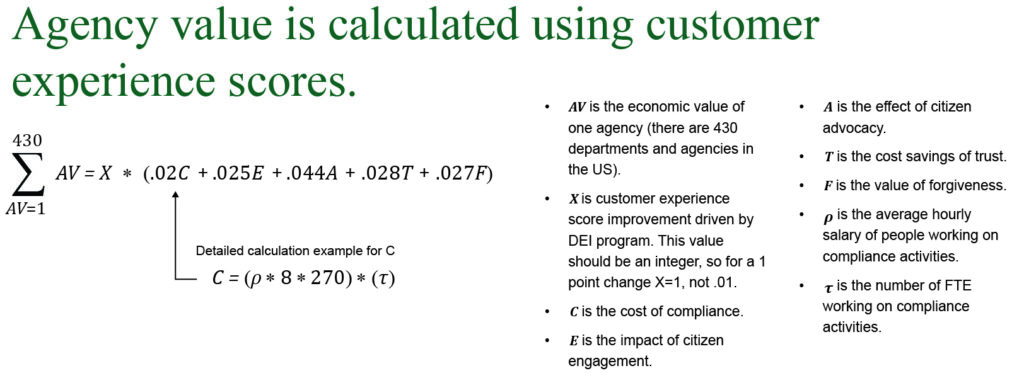The Total Economic Impact™ Of DEI: Why Diversity, Equity, And Inclusion Matter
I recently caught up with an old colleague named Alberto, and beyond the standard “How are you doing?” questions, we naturally started to talk about work.
He’s a director of merchandising for a regional grocery chain, and he told me about a recent meeting he had where he (in his words, not mine) made the best presentation of his career. He was in a line review going over products for the dairy category. In the meeting, he and other category teams, the chief merchant, and various vice presidents discussed yogurt, cottage cheese, sour cream, and those types of items.
Finally, when they got to the Hispanic items the stores offer (which is his area of coverage), he began with this simple question: “Can anyone tell me what the number one item is in store number 612?” That store was the closest to the organization’s corporate office and just three miles away. Immediately, the educated guesses started to flow.
“Vanilla yogurt!”
“Orange juice!”
Despite the expertise of those gathered, nobody guessed the right answer. Alberto followed up his question with this: “What I didn’t tell you is that store number 612 has a high population of Hispanic shoppers. And if you look at that store, and if you look at all the dairy items we’re reviewing today, the four top-selling items are not vanilla yogurt or orange juice; they’re Dolores Tuna, El Mexicano drinkable yogurt, corn masa, and queso fresco. You must understand your customer at the store level. If not, you may make blanket assumptions like that and not cater to the diverse demographics around the country, such as those of a Hispanic neighborhood.”
That story stayed with me as it shows the power that representation can have not only on business decisions but also the effect it can have on the bottom line. And in today’s society, representation can’t be an afterthought. It must be part of your strategy.
As a member of Forrester’s Total Economic Impact™ (TEI) team, I’ve heard about similar challenges with addressing diversity, equity, and inclusion (DEI) from multiple agencies in the public sector. While most public sector agencies don’t have a bottom line, they do have a mission and a duty to the communities they (and their employees) serve.
With the recent release of Executive Order 13985, (and subsequent release of the Executive Order on Diversity, Equity, Inclusion, and Accessibility in the Federal Workforce) government agencies are being asked to conduct assessments and to show strategic approaches around DEI initiatives. The executive order says that “Entrenched disparities in our laws and public policies, and in our public and private institutions, have often denied [ … ] equal opportunity to individuals and communities.”
To improve representation in government, agencies should expand their listening strategies to encompass the full spectrum of diversity present in their communities and pursue comprehensive approaches for equity of all. By doing this, agencies can also improve their customer experience (CX) by ensuring that they represent all citizens equally and fairly.
To help these organizations get support and buy-in for their DEI initiatives and programs, Forrester developed the following approach:
Engage In Active Listening
This sounds fancy, but it’s really just plain old listening mixed with action. If you want to better serve people, you need to ask them what they want and then act. Forrester Principal Analyst Katy Tynan reminded us in her report The Business Of Belonging that “If you want more customers, target more groups of customers.” If the leaders of Alberto’s organization hadn’t listened to his feedback and didn’t look at the demographics, they would have missed out on the local populations that had access to their stores.
Empower Your Employees
Alberto’s company was successful because it empowered its employees — the people who engage with customers every day — to make the right decisions. Its leaders visited the organization’s most diverse stores around the country to see what happens when the company caters to specific neighborhoods and customers. Rather than rely on traditional customer data, they embraced a multicultural approach to merchandising, and they made it as important of an initiative as others in the organization. It’s easy to consider policy creation to be a top-down exercise. But that’s the kind of policy change to table. Instead, create a dialogue with employees to ensure that the policy fits the organization.
Continue To Embrace Customer Experience
Forrester’s research validates this approach, but the government needs to go further. Consumers expect more from their brands, and companies are embracing social values in light of social movements. Citizens now have similar expectations about government agencies. In his report Why And How To Improve Government CX, Forrester Vice President and Principal Analyst Rick Parrish highlighted how stronger CX can lead to smoother legislation rollouts, increased faith in government entities, and ultimately lower costs for government agencies to run important programs.
Focus On Building Trust
Without trust, it’s easy to mistake any government action as an overreach. If citizens lose trust in their governments or they have substandard experiences with agencies, they’ll opt out of surveys. As Parrish wrote, this can “[hamper] mission success.” Citizens aren’t going to respond to surveys at the same rate, and they may opt out or be unaware of local community initiatives and federal programs. Once a portion of the community feels alienated, agencies can never get a true, holistic view of the citizens they represent because the data will misrepresent the population.
Think Like A Brand
Whether public sector agencies realize it or not, each one has a brand, and it’s imperative that they take ownership of those brands, because the news cycle does. In Design A Program To Advance Race And Gender Fairness And Equity, Forrester Vice President and Principal Analyst Dipanjan Chatterjee explained how brands can better align themselves to what matters to their constituents — and to the larger community — in ways that demonstrate value.
Combining Forrester’s CX Research Allows Us To Create An Economic Model For Valuing DEI
But that leaves the big question: Since public sector agencies don’t have a bottom line, how can you put a value to it? It’s not an academic question (although it may be considered a philosophical one) or one that should be ignored because of the social good that comes from these actions. Before we dive in, I want to give you a “math advisory warning.” Forrester’s Total Economic Impact team is dedicated to putting value to the intangible. If you’re someone who tends to avoid parties where numbers and letters come together (i.e., algebra), click here to schedule a call with a member of our team.
Studies prove that good data and a positive customer experience can generate millions of dollars in business profit. But instead of generating profit, we can use a similar model to generate agency value. In plain terms, improving agency value can often have the added effect of reducing costs (and improving sales). For example, people sort their recyclables, buy park passes, and buy energy-efficient appliances and electric cars.
Therefore, agency value can be calculated based on the following five factors: compliance, engagement, advocacy, trust, and forgiveness. In the formula below, “C” represents compliance, “E” represents customer engagement, “A” represents customer advocacy, “T” represents trust, and “F” represents forgiveness.
As Rick Parrish’s research shows, when government agencies improve their CX experiences for their citizens, it’s proven that they:
- C: Drive better compliance by 2%. This means more customers do what the organization asks of them.
- E: Engage more customers to seek advice by 2.5%. And 3% of those customers will sign up for benefits and services that aren’t mandatory.
- A: Inspire customers by 4.4% to say positive things about the organization.
- T: Earn 2.8% more trust from customers.
- F: Create 2.7% more empathy as more customers forgive businesses of their mistakes.
Essentially, as CX improves, more customers will comply with a department’s directives, engage with it proactively, speak well of it, trust it, and forgive its mistakes. And if the data is holistic and allows for true representation, it will allow government operations to cost less and run more smoothly.
To paraphrase Rick’s research a bit, the economic model below can help you start to calculate the impact of DEI by identifying tangible improvement that lead to measurable value and mission outcomes. As agencies make improvements around their DEI initiatives, this model can show the benefits of those efforts.

By understanding their citizens, agencies have the ability to connect with them in a way that enables and creates more effective policy and governance practices.
Like Alberto and his team saw, when systems are tailored to allow employees to help customers in the community, a greater representation of the wallet share will follow. If you are in the public sector, continue to gather diverse opinions and perspectives and foster innovation to help your agency redesign programs in a way that will be valuable to everyone.
